T.S. Rhodes's Blog, page 14
August 17, 2015
The Pirate Island of Tortuga
Tortuga is probably the most famous piece of real estate ever claimed by pirates. Though they formed the actual government of the Bahamas for nearly four years, and created a society so wicked in the city of Port Royal that the 1697 earthquake was called the “wrath of God”, Tortuga stands out by reputation. How did this come to be?
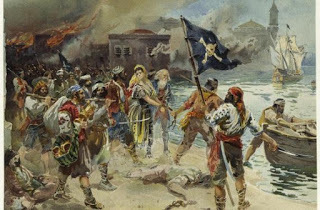
Like most of the Caribbean, the Isle de Tortuga was first claimed by the Spanish. In fact, it was first spotted by none other than Christopher Columbus himself, who spotted it on his very first voyage on December 6th, 1492. As the contours of the island emerged from the morning mist, Columbus was reminded of a turtle’s shell, and named the place accordingly. “Isle de Tortuga” means “turtle island”, plain and simple.
Of course, there are a lot of islands that look like the backs of turtles, and “Tortuga”-s can be found all over the world, including the “dry Tortugas” off the coast of Florida, “Tortuga” off the coast of California, and a couple of uninhabited Tortugas off the coast of South America. But for Pirates, there is only one real Tortuga. It lies in the Windward Passage, between Cuba and the island of Hispaniola.
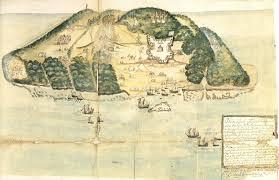
A few Spanish lived on the island by 1625, and French and English settlers soon followed, having been foiled in their efforts to take up residence on Hispaniola. In 1629 they were chased off by Don Fadrique de Toledo, who chased them off and built a fort. Then most of the Spansih army left to chase the French off of Hispaniola, and the French and English came right back, taking over the fortifications that the Spanish had left behind.
Spain’s problem was that it was trying to claim half the world – without the manpower to keep it. The English, French and Dutch followed the pirate creed… If the land was far enough away and no one was watching it too closely, it was up for grabs.

This was the era of the Buccaneering Pirates… Quasi-legal adventurers who often struck at land-based objectives and funneled money back to their respective governments. Tortuga was a convenient spot to gather ships and supplies before striking out to attack either Cuba, Florida or Hispaniola From 1630 onward, the French, the English and some Dutch occupied the island together, though when their nations were at war, they sometimes fought between themselves.
The level of chaos evident on the island may be hinted at by this fact: Africans slaves were introduced in 1633, but the practice of importing them was discontinued only two years later because they were “running wild.”
Between 1635 and 1640, Spain re-conquered and lost the island twice more. Though their nearby military might gave them the ability to strike effectively, the strategic value of the tiny island simply didn’t seem to merit leaving a force large enough to hold it.
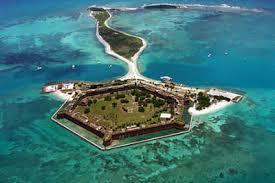
By 1640, the French, English and Dutch buccaneers of Tortuga were calling themselves the Brethren of the Coast, and were causing chaos with shipping, often without regard to the nationality of the ships concerned. The French exerted the most control over the island, which was still not much. In 1645, the acting French governor found a remarkable method of getting the pirates under some kind of control. He imported approximately 1,650 prostitutes, hoping to give the pirates something less warlike to do.
In 1654, the Spanish captured the island for the fourth and final time. The pirates took it back less than a year later.
This time the English had the upper hand. Elias Watts secured a commission from the acting military governor of Jamaica to serve as “governor” of Tortuga. Five years later, the English, for reasons unknown, appointed a Frenchman, Jeremie Deschamps, to the position. Deschamps promptly claimed the island for the King of France, hoisted French colors over the previously Spanish/English/French fort, and defeated several English attempts to regain control.
By 1670 European powers were no longer quite so comfortable supporting the wild, lawless raiding of the buccaneers, and the buccaneer era was in decline. Many of the pirates turned to log cutting and wood trading as a new income source. Then a Welsh privateer named Captain Henry Morgan began his career, and invited the pirates to sail under him for the ostensible purpose of protecting England’s newly-acquired colony of Jamaica. French forces also used the pirates as hired guns to improve their position in the Caribbean. Tortuga remained a neutral hideout and place to party.
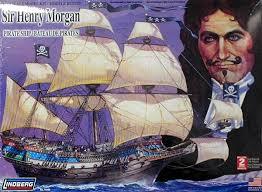
Law and order was on a slow upswing, though. By 1680 it was illegal for the English to sail under foreign flags, and many of the pirates, who had been working for their respective navies off-and-on, for years, made it official and became permanent members of their respective nations’ military.
Tortuga remained famous in song and story however. Rafael Sabatini (1875-1950) the author of such timeless pirate classics as The Sea Hawk, Captain Blood, and The Black Swan, mentioned the island in many of his tales, and then these stories were filmed in by Hollywood, the legend of Tortuga only grew.
Today, Tortuga can be found on television (Black Sails) video games (Assassin’s Creed IV Black Flag, and The Curse of Monkey Island, among many others) and, of course, in the Pirates of the Caribbean movies, where it represents the epitome of pirate culture.
To quote Captain Jack Sparrow, “If every town in the world was like this one, no man would ever feel unwanted.” Legacy of those 1,650 French prostitutes.


Like most of the Caribbean, the Isle de Tortuga was first claimed by the Spanish. In fact, it was first spotted by none other than Christopher Columbus himself, who spotted it on his very first voyage on December 6th, 1492. As the contours of the island emerged from the morning mist, Columbus was reminded of a turtle’s shell, and named the place accordingly. “Isle de Tortuga” means “turtle island”, plain and simple.
Of course, there are a lot of islands that look like the backs of turtles, and “Tortuga”-s can be found all over the world, including the “dry Tortugas” off the coast of Florida, “Tortuga” off the coast of California, and a couple of uninhabited Tortugas off the coast of South America. But for Pirates, there is only one real Tortuga. It lies in the Windward Passage, between Cuba and the island of Hispaniola.

A few Spanish lived on the island by 1625, and French and English settlers soon followed, having been foiled in their efforts to take up residence on Hispaniola. In 1629 they were chased off by Don Fadrique de Toledo, who chased them off and built a fort. Then most of the Spansih army left to chase the French off of Hispaniola, and the French and English came right back, taking over the fortifications that the Spanish had left behind.
Spain’s problem was that it was trying to claim half the world – without the manpower to keep it. The English, French and Dutch followed the pirate creed… If the land was far enough away and no one was watching it too closely, it was up for grabs.

This was the era of the Buccaneering Pirates… Quasi-legal adventurers who often struck at land-based objectives and funneled money back to their respective governments. Tortuga was a convenient spot to gather ships and supplies before striking out to attack either Cuba, Florida or Hispaniola From 1630 onward, the French, the English and some Dutch occupied the island together, though when their nations were at war, they sometimes fought between themselves.
The level of chaos evident on the island may be hinted at by this fact: Africans slaves were introduced in 1633, but the practice of importing them was discontinued only two years later because they were “running wild.”
Between 1635 and 1640, Spain re-conquered and lost the island twice more. Though their nearby military might gave them the ability to strike effectively, the strategic value of the tiny island simply didn’t seem to merit leaving a force large enough to hold it.

By 1640, the French, English and Dutch buccaneers of Tortuga were calling themselves the Brethren of the Coast, and were causing chaos with shipping, often without regard to the nationality of the ships concerned. The French exerted the most control over the island, which was still not much. In 1645, the acting French governor found a remarkable method of getting the pirates under some kind of control. He imported approximately 1,650 prostitutes, hoping to give the pirates something less warlike to do.
In 1654, the Spanish captured the island for the fourth and final time. The pirates took it back less than a year later.
This time the English had the upper hand. Elias Watts secured a commission from the acting military governor of Jamaica to serve as “governor” of Tortuga. Five years later, the English, for reasons unknown, appointed a Frenchman, Jeremie Deschamps, to the position. Deschamps promptly claimed the island for the King of France, hoisted French colors over the previously Spanish/English/French fort, and defeated several English attempts to regain control.
By 1670 European powers were no longer quite so comfortable supporting the wild, lawless raiding of the buccaneers, and the buccaneer era was in decline. Many of the pirates turned to log cutting and wood trading as a new income source. Then a Welsh privateer named Captain Henry Morgan began his career, and invited the pirates to sail under him for the ostensible purpose of protecting England’s newly-acquired colony of Jamaica. French forces also used the pirates as hired guns to improve their position in the Caribbean. Tortuga remained a neutral hideout and place to party.

Law and order was on a slow upswing, though. By 1680 it was illegal for the English to sail under foreign flags, and many of the pirates, who had been working for their respective navies off-and-on, for years, made it official and became permanent members of their respective nations’ military.
Tortuga remained famous in song and story however. Rafael Sabatini (1875-1950) the author of such timeless pirate classics as The Sea Hawk, Captain Blood, and The Black Swan, mentioned the island in many of his tales, and then these stories were filmed in by Hollywood, the legend of Tortuga only grew.
Today, Tortuga can be found on television (Black Sails) video games (Assassin’s Creed IV Black Flag, and The Curse of Monkey Island, among many others) and, of course, in the Pirates of the Caribbean movies, where it represents the epitome of pirate culture.
To quote Captain Jack Sparrow, “If every town in the world was like this one, no man would ever feel unwanted.” Legacy of those 1,650 French prostitutes.

Published on August 17, 2015 17:13
August 10, 2015
Pirates, Sailors and Fiddler’s Green
Did pirates go to heaven?

All European pirates were at least nominally Christian. This is not remarkable, because in Europe at the time, one needed to be Christian to live among other people. Children were baptized early, as the ritual was supposed to protect the child and, since many people died very young, it was also necessary to make sure the child got into heaven.
The word “Christian” meant a lot more at the time that “an adherent of the Christian church.” It was often used to mean “proper”. Thus, a sailor might to told to “Furl that line like a Christian” when the line was supposed to be furled neatly and put away in its proper place. The opposite of “Christian” wasn’t “Atheist” it was “savage” – a wild person with no sense of propriety, order or decency. And people believed, quite firmly and literally, that only good Christians would get into heaven and avoid the fires of Hell. This attitude filtered down even to pirates, who worried about their immortal souls as much as anyone.

This is even shown in the Pirates of the Caribbean series. One pirate says to another “Leave me alone, I’m reading the Bible.”
The other pirate replies, “You can’t read!”
His friend replies, “You get points for trying.”
This brings us to the fact that few sailors, and fewer pirates, had a chance to lead a Christian life. The religion was tied into community, and pirates had little in the way of community, being wanderers. They rarely, if ever, had a chance to attend church. They often did not marry (which was considered an important part of Christian life). They got drunk, hired prostitutes, fought, and took things that did not belong to them. And for people who believed quite literally in Heaven and Hell, this was a real problem.
Even swearing was considered a major sin by the Christian churches, and pirates (like other sailors) swore constantly. They were known for it.

(As an aside, recent scientific studies have shown that shouting a swear word can temporarily block pain, and that it can also provide an adrenaline rush that improves strength. In world where pain came regularly, and near-superhuman strength was needed to haul ropes, swearing must have been a useful tool.)
Pirates accepted that they were going to Hell, and sometime owned it as a matter of bravado, rather like a modern-day biker with a tattoo that says, “Heaven doesn’t want me and Hell is afraid I’ll take over.” However, there was an alternative. Sailors, understanding that their lives lay outside of the normal round of Christian life, invented a heaven of their own.
This place was called Fiddler’s Green. Descriptions of it go back at least to 1685, when a description of it appears under the name of “Lubberland.”

Fiddler’s Green grew in the telling, but it was a place where there was always music, and where dancers never got tired. There was plenty to eat – pudding, meat, pie, candy. Tobacco and alcohol were plentiful and free. Often a sailor's soul in Fiddler’s Green was tied to a ship, but on these magic ships there was no work. The wind always blew fair, and if one was fishing, the fish jumped into the net of their own accord.
Often in this place, the low were raised high and the mighty were laid low. A ship’s captain served his crew, preparing food for them and sharing his whiskey. Landlords never needed to be paid. (Many men who first went to sea were farmers whose families had been evicted from the a farm they had held for generations.) There were no lawyers.

And when one came to land, the locals wee welcoming (rather than suspicious of strangers) and the girls were all pretty and friendly. Rivers and streams flowed with wine, trees grew roast meat and sugar, and the streets were paved with gold. Everyday people wore silk and satin clothing. The weather was never too hot or too cold (though apparently Fiddler’s Green had the usual seasons in the usual order).
It wasn’t heaven. It was a special place for sailors, and all one had to do to get in was to “serve his time” at sea.
The opposite of this was Davy Jones’ locker. Simply put, Davy Jones was another name for the Devil. The name was safer to use than calling him Satan the Devil. His job was to take the souls of dead men down below the sea, and keep them forever. Few, if any stories actually tell about this. To be taken to the bottom of the cold, dark, crushing water, and kept there in chains by an evil spirit was bad enough.

To earn one’s way into Fiddler’s Green, a man had to be honest with his fellows, and hard-working. And he needed to have suffered as a sailor. Since most sailors were beaten regularly, and endured bad food, harsh weather, sickness, and unfair treatment, this wasn’t hard to achieve.
However, ritual was also helpful in getting to Fiddler’s Green. Though it wasn’t necessary, being properly buried, either at sea or on land, was a big help.
This became a recruiting tool for pirates. They offered a new recruit the guarantee of some sort of funeral service upon his passing, usually a full burial. Emergencies like storms or battle might delay the ceremony, but the recruit was promised that it would be held. Merchant captains often did not provide this, especially if they were in a hurry, or even simply did not like the sailor in question.
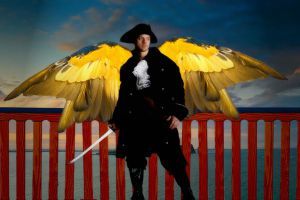
So there you have it – One more reason to become a pirate. Your own personal heaven.
Published on August 10, 2015 19:02
August 3, 2015
How to Find Pirate Treasure
Pirate treasure! Who doesn’t dream of digging into the warm sand of a Caribbean beach and bringing out handfuls of doubloons, piles of pesos, stacks of silver and piles of pearls? And ever since Barry Clifford discovered the wreck of the Whydah in 1987 and cleaned up with a sweet $26,000,000.00, it’s been acknowledged that there’s still treasure to be found.
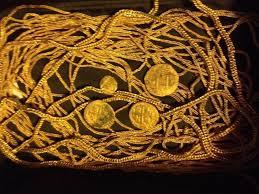
So how does one go about bringing in the gold?
Barry famously found his treasure map on the back shelves of his public library, so you if you live along the eastern coast of North or South America, you might hit you local public records office, library, or other records depository to scope out records of local shipwrecks. Enormous amounts of gold and silver were shipped to Europe during Spain’s exploitation of the New World, and the wrecks of these treasure vessel are the best way to pick up some gold.
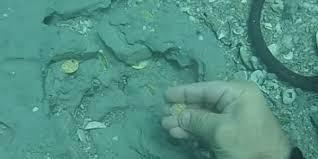
New discoveries pop up all the time. On June 17thof this year (2015), Eric (not the one of Google fame) was diving near the site of the 1715 Spanish Treasure Fleet wrecks, and found over a million dollars worth of gold, in the form of 40 feet of solid gold chain and 41 gold coins. The coins, some of which are among the most beautiful and best preserved of their kind, include a solid gold “Royal” intended for presentation to the King of Spain.
It would be wonderful to believe that you might do the same, but sadly there are legal considerations. After all, when the possibility of treasure comes up, everyone wants a piece. In this case, the right to scavenge the wrecks belongs to the company: 1715 Fleet – Queens Jewels who paid the government for the right. The Schmidt family had subcontracted to search the area for valuables.
Even with the known location of the wrecks, it has still taken years to bring up the treasure. Eric speaks of many fruitless hours turning over bits of garbage on the ocean floor, looking for something shiny. This time the effort paid off, at the cost of boats, diving equipment, and lots and lots of time. Treasure hunting ain’t easy.
[image error]
But gold coins still occasionally wash up on the Florida beaches. It’s possible to get lucky.
Legendary treasures still await. Although most pirates had no interest in burying treasure, it has been rumored for years that Captain Kidd, a pirate who started out as a privateer, buried some of his ill-gotten gains. Some treasure was dug up and sent to England, where it served as evidence in Kidd’s trial. But additional riches are said to remain, and treasure hunters have gone digging after Kidd’s legendary gold from Connecticut to Madagascar. In 1983, Cork Graham and Richard Knight thought they could find his treasure in Vietnam. They landed illegally on the island of Phu Quoc and were arrested, fined $10,000 each and kept in prison for 11 months, until they could pay the fine.

You could always search for the lost treasure of Lima. Not quite pirate era, it is nonetheless Spanish gold, which was taken from the natives and held in a treasure stronghold until 1823, when native rebellion forced the government to try and evacuate the gold. These officials hired and English ship hold the treasure offshore until the rebellion died down. But Captain William Thompson decided to turn pirate instead and sail off with his ill-gotten gains.
The Spanish eventually caught up to them, and executed everyone except the captain and first mate, who promised to take their captors to where the gold was buried. They led the Spanish to Cocos Island, near Costa Rica, and then ran off into the jungle and were never seen again. Neither was the gold. Was it ever really there? Or did the wily Captain Thompson simple lead the Spanish to a place he could disappear from? We may never know.
Pirates almost always spent their plunder, rather than bury it or hide it away. But the legends – possibly fueled by Kidd’s actual actions (He was trying to hide his income and avoid paying men who had invested in his privateering operation.) remain. Other semi-believable tales are told as well. Olivier Levasseur tried to confuse matters at his own hanging by throwing a piece of paper into the crowd and shouting, “The treasure to he who solves it!” No one has ever “solved” the mass of seemingly random numbers.
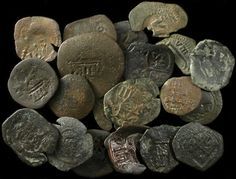
Of course, if you just want some pirate treasure, you can do what I did, and buy some. I have a small hoard of “pirate pennies”. Battered almost beyond recognition and worth only a fraction of a cent when they were new, they have nonetheless touched the hands of REAL three-hundred-year-old pirates.
You, too, can purchase pirate treasure. Coins from the Schmidt family’s find will probably be on the market soon, and there are many other treasure dealers, mostly along the east coast. But beware! Real coins are so valuable that many forgeries exist. Expect to pay between $1,200 and $2,400 for a single gold doubloon.
Why so much? Part of the issue is supply and demand. People will pay for pirate artifacts, and the more well-documented the better. But there’s also the issue of the gold involved. Many of these coins were made from an ounce of solid 22 carat gold, a purity that is rarely found today. Even melted down, they’d be worth a fortune.
[image error]
If you vacation in Jamaica, you might also like to go snorkling over the site of the old city of Port Royal. This historic town more closely resembled the fictional Tortuga than any more law-abiding place. Pirates roamed the city freely for 20 years, and there were almost more taverns than permanent residents, until two thirds of the town sank in a massive earthquake that some attributed to the Wrath of God.
On some tours, participants are free to pick up anything they like in the wreck of the old city. Broken pipe-stems are common, along with equally broken rum bottles. But gold may lurk. You never know!

So how does one go about bringing in the gold?
Barry famously found his treasure map on the back shelves of his public library, so you if you live along the eastern coast of North or South America, you might hit you local public records office, library, or other records depository to scope out records of local shipwrecks. Enormous amounts of gold and silver were shipped to Europe during Spain’s exploitation of the New World, and the wrecks of these treasure vessel are the best way to pick up some gold.

New discoveries pop up all the time. On June 17thof this year (2015), Eric (not the one of Google fame) was diving near the site of the 1715 Spanish Treasure Fleet wrecks, and found over a million dollars worth of gold, in the form of 40 feet of solid gold chain and 41 gold coins. The coins, some of which are among the most beautiful and best preserved of their kind, include a solid gold “Royal” intended for presentation to the King of Spain.
It would be wonderful to believe that you might do the same, but sadly there are legal considerations. After all, when the possibility of treasure comes up, everyone wants a piece. In this case, the right to scavenge the wrecks belongs to the company: 1715 Fleet – Queens Jewels who paid the government for the right. The Schmidt family had subcontracted to search the area for valuables.
Even with the known location of the wrecks, it has still taken years to bring up the treasure. Eric speaks of many fruitless hours turning over bits of garbage on the ocean floor, looking for something shiny. This time the effort paid off, at the cost of boats, diving equipment, and lots and lots of time. Treasure hunting ain’t easy.
[image error]
But gold coins still occasionally wash up on the Florida beaches. It’s possible to get lucky.
Legendary treasures still await. Although most pirates had no interest in burying treasure, it has been rumored for years that Captain Kidd, a pirate who started out as a privateer, buried some of his ill-gotten gains. Some treasure was dug up and sent to England, where it served as evidence in Kidd’s trial. But additional riches are said to remain, and treasure hunters have gone digging after Kidd’s legendary gold from Connecticut to Madagascar. In 1983, Cork Graham and Richard Knight thought they could find his treasure in Vietnam. They landed illegally on the island of Phu Quoc and were arrested, fined $10,000 each and kept in prison for 11 months, until they could pay the fine.

You could always search for the lost treasure of Lima. Not quite pirate era, it is nonetheless Spanish gold, which was taken from the natives and held in a treasure stronghold until 1823, when native rebellion forced the government to try and evacuate the gold. These officials hired and English ship hold the treasure offshore until the rebellion died down. But Captain William Thompson decided to turn pirate instead and sail off with his ill-gotten gains.
The Spanish eventually caught up to them, and executed everyone except the captain and first mate, who promised to take their captors to where the gold was buried. They led the Spanish to Cocos Island, near Costa Rica, and then ran off into the jungle and were never seen again. Neither was the gold. Was it ever really there? Or did the wily Captain Thompson simple lead the Spanish to a place he could disappear from? We may never know.

Pirates almost always spent their plunder, rather than bury it or hide it away. But the legends – possibly fueled by Kidd’s actual actions (He was trying to hide his income and avoid paying men who had invested in his privateering operation.) remain. Other semi-believable tales are told as well. Olivier Levasseur tried to confuse matters at his own hanging by throwing a piece of paper into the crowd and shouting, “The treasure to he who solves it!” No one has ever “solved” the mass of seemingly random numbers.

Of course, if you just want some pirate treasure, you can do what I did, and buy some. I have a small hoard of “pirate pennies”. Battered almost beyond recognition and worth only a fraction of a cent when they were new, they have nonetheless touched the hands of REAL three-hundred-year-old pirates.
You, too, can purchase pirate treasure. Coins from the Schmidt family’s find will probably be on the market soon, and there are many other treasure dealers, mostly along the east coast. But beware! Real coins are so valuable that many forgeries exist. Expect to pay between $1,200 and $2,400 for a single gold doubloon.
Why so much? Part of the issue is supply and demand. People will pay for pirate artifacts, and the more well-documented the better. But there’s also the issue of the gold involved. Many of these coins were made from an ounce of solid 22 carat gold, a purity that is rarely found today. Even melted down, they’d be worth a fortune.
[image error]
If you vacation in Jamaica, you might also like to go snorkling over the site of the old city of Port Royal. This historic town more closely resembled the fictional Tortuga than any more law-abiding place. Pirates roamed the city freely for 20 years, and there were almost more taverns than permanent residents, until two thirds of the town sank in a massive earthquake that some attributed to the Wrath of God.
On some tours, participants are free to pick up anything they like in the wreck of the old city. Broken pipe-stems are common, along with equally broken rum bottles. But gold may lurk. You never know!
Published on August 03, 2015 15:08
July 27, 2015
How to Write a Pirate Story Part 2 – Creating a Memorable Pirate Character
If you want to create a notable pirate character, there is some good news and some bad news. The good news is that many other writers have done, or tried to do, the same thing and you can learn from their triumphs and mistakes. The bad news is that your character will be competing with some of the most famous and iconic characters of all time.

Let us start with the earliest example of a famous pirate – Long John Silver from Treasure Island. He’s one of the most well-known of pirates, and also the guy who began the image of the pirate with a peg-leg (thought Silver never actually had a peg, using a crutch to walk instead).
Silver is famous for both his ruthlessness and his humor. He is a man dedicated to one goal – the retrieval of Captain Flint’s buried treasure. He will do anything to get it…. He starts off by selling his prosperous business. He lies, cheats, bullies men stronger than himself, stands down a mutiny, all in the name of the buried gold.
But at the same time, Silver is everybody’s friend, at least on the surface. As the ship’s cook, he has opportunity to pass out treats and extra food rations to both his compatriot pirates and his young protégé, Jim Hawkins. He is subservient to Lord Trelawney and the ship’s officers, even as he is plotting to kill them. And he comes to genuinely love Jim.
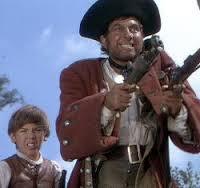
So, like a real person, Silver is a mass of contradictions. Kind but ruthless, intelligent, but with limited goals, a leader with no official title, a terrifying bad-guy who is also a cripple. (It should be noted that Silver was based on a real person, a man of great character, who had lost a leg to disease.) These should be the rules for creating any fictional character- or at least one that you intend to be a star. Build in contradictions. Somehow, if he had not been missing a leg, Silver would not have been so frightening.
And yet, I believe that even these contradictions are not the final touch that seals Sliver as such a great pirate. What makes him stand out is his softness for Jim Hawkins. He gives up everything, simply because Jim is a young man who has looked up to Silver, and Silver sees the good in the boy. That’s the moment – when the one-legged pirate pulls his pistols and stands up to his own men, for the sake of a boy who cannot help him at all, that Silver wins out heats.

To put it simply, Silver’s greatest strength – his ruthlessness – is overcome by his greatest weakness – his love for Jim.
Remember that – a really good pirate is neither all good not all bad.
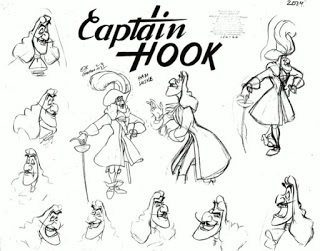
But what about Captain Hook? This is a bad guy. His nemesis is an innocent child. He kidnaps an Indian princess, threatens to murder the Darling children, captures and nearly kills Tinkerbell. (Murdering fairies, for heaven’s sake!). Where is the redeeming feature that makes Captain Hook more than a cartoon bad-guy?
Because, like so many people in the audience, Hook can never have what her really wants. Hook wants to be a proper English gentleman. He betrays this by his insistence on “good form”, by his careful diction, his immaculate clothing. Hook went to Eaton, and sets a great importance on this (his dying works are Eaton’s motto).
Hook is, in some ways, the ultimate Adult to peter’s ultimate child. Like adults (especially adults as seen by children) Hook is all hung up on appearances. He needs to dress right, use the right manners, to always be in control. Unlike the “Indians” who admit they are playing a long-running game with Peter and the Lost Boys, Hook is serious.
But Hook’s problem is that his is, at heart, a coward. And he hates himself for it. He’s not only defeated by a child – Peter – but he is humiliated by him. Hook admits to being a “codfish” and weeps with terror when his own life is on the line. This turns his elegance and self-possession on its head.
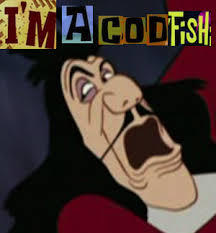
Hook has a lot in common with Daffy Duck. They both care much-too-much about winning, and as a result, they fail. Daffy’s comic failures make us love him; Hook’s failures take some of the bite out of his truly frightening and horrible behavior.
Hook also has Smee, another of our famous pirates. Smee is the opposite of Hook. Where Hook is formal and passionate, Smee is easy-going; when Hook is well-dressed, Smee is comfortable. They complement each other. Smee is a good reminder to all writers that no pirate stands alone, and that a single well-drawn side-kick can stand in for a whole crew. Imagine for a moment if Smee was a heartless killer like Hook? The pirates would lose all their humor and be too frightening, rather than frightening and fun.

And speaking of “fun pirates”, what can we learn from Captain Jack Sparrow? It’s interesting to note that all of the pirates on this list have a simple theme behind them. Long John Silver is a ruthless killer with a heart of gold. Hook is a fearsome pirate with perfect manners, who conceals his own cowardice. And Smee is the perfect sidekick, the guy who keeps Hook form being too scary. Captain Sparrow also has a simple concept – he is a pirate who lives like a rock-star.
How does Captain Sparrow accomplish this? Well, for one thing, he reads his own reviews and writes his own press releases. Jack takes his reputation very seriously. His pronouncements –You will remember this as the day that you almost caught Captain Jack Sparrow…- are funny, but they also tell us a lot about what Jack cares about. And what he cares about his being famous. This is a relatable goal, especially for modern audiences. We’d like to be famous, too.
The fact that Jack doesn’t quite succeed in his plans for fame – even as he’s being hanged, the authorities refuse to acknowledge his as “Captain” – makes us care for him more. He’s got our sympathy.

But Johnny Depp did one more thing that cemented Jack as a pirate of historic significance… When confronting Will Turner in the blacksmith shop, Johnny was supposed to tell Will “This shot is not for you” and then cock the pistol. Jack Sparrow cocked the pistol first, then said the line. This is important, because it sent a message that Jack was serious. He didn’t WANT to kill Will, but he would, if necessary. The threat was real. And the threat of actually killing Will keeps all of Sparrow’s other problems… His wandering walk, his issues with the authorities, his loss of the rum… He will kill people, even an innocent like Will. Without the threat, he’s no fun.
What have we learned? A memorable pirate character needs to have a good mix of threat and sympathy. It should be well-rounded, having the kind of internal contradictions that real people have. The pirate should not exist alone… One pirate needs other pirates to be an effective character, and the contrasts between pirates offer depth and interest. And last of all, it’s a wonderful touch to have the pirate’s greatest strength also be his or her greatest liability.

I have high hopes for my own character, Scarlet MacGrath. As a female pirate captain, she stands out from the crowd. But she also faces problems caused by her gender. She a realistic woman in that she can’t go toe-to-toe with a man in a fist fight. The men around her are too strong. But she makes her weakness into strength by out-thinking her opponents.
Scarlet means business… She will kill if she has to. But she doesn’t want to. In fact, my fearsome, treasure-loving, pistol-shooting, sword-carrying Irishwoman secretly longs for a home, a husband, and a couple of kids.
See how that’s working out for her in my pirate novels, Gentlemen and Fortune, in which Scarlet meets old enemies and new lovers, and handles treasures of many kinds. And in Bloody Seas, where she confronts bloodthirsty natives, old enemies, and a Royal Navy Captain that she doesn’t know if she’d like to kill or kiss…
http://www.amazon.com/TS-Rhodes/e/B00...

Let us start with the earliest example of a famous pirate – Long John Silver from Treasure Island. He’s one of the most well-known of pirates, and also the guy who began the image of the pirate with a peg-leg (thought Silver never actually had a peg, using a crutch to walk instead).
Silver is famous for both his ruthlessness and his humor. He is a man dedicated to one goal – the retrieval of Captain Flint’s buried treasure. He will do anything to get it…. He starts off by selling his prosperous business. He lies, cheats, bullies men stronger than himself, stands down a mutiny, all in the name of the buried gold.
But at the same time, Silver is everybody’s friend, at least on the surface. As the ship’s cook, he has opportunity to pass out treats and extra food rations to both his compatriot pirates and his young protégé, Jim Hawkins. He is subservient to Lord Trelawney and the ship’s officers, even as he is plotting to kill them. And he comes to genuinely love Jim.

So, like a real person, Silver is a mass of contradictions. Kind but ruthless, intelligent, but with limited goals, a leader with no official title, a terrifying bad-guy who is also a cripple. (It should be noted that Silver was based on a real person, a man of great character, who had lost a leg to disease.) These should be the rules for creating any fictional character- or at least one that you intend to be a star. Build in contradictions. Somehow, if he had not been missing a leg, Silver would not have been so frightening.
And yet, I believe that even these contradictions are not the final touch that seals Sliver as such a great pirate. What makes him stand out is his softness for Jim Hawkins. He gives up everything, simply because Jim is a young man who has looked up to Silver, and Silver sees the good in the boy. That’s the moment – when the one-legged pirate pulls his pistols and stands up to his own men, for the sake of a boy who cannot help him at all, that Silver wins out heats.

To put it simply, Silver’s greatest strength – his ruthlessness – is overcome by his greatest weakness – his love for Jim.
Remember that – a really good pirate is neither all good not all bad.

But what about Captain Hook? This is a bad guy. His nemesis is an innocent child. He kidnaps an Indian princess, threatens to murder the Darling children, captures and nearly kills Tinkerbell. (Murdering fairies, for heaven’s sake!). Where is the redeeming feature that makes Captain Hook more than a cartoon bad-guy?
Because, like so many people in the audience, Hook can never have what her really wants. Hook wants to be a proper English gentleman. He betrays this by his insistence on “good form”, by his careful diction, his immaculate clothing. Hook went to Eaton, and sets a great importance on this (his dying works are Eaton’s motto).
Hook is, in some ways, the ultimate Adult to peter’s ultimate child. Like adults (especially adults as seen by children) Hook is all hung up on appearances. He needs to dress right, use the right manners, to always be in control. Unlike the “Indians” who admit they are playing a long-running game with Peter and the Lost Boys, Hook is serious.
But Hook’s problem is that his is, at heart, a coward. And he hates himself for it. He’s not only defeated by a child – Peter – but he is humiliated by him. Hook admits to being a “codfish” and weeps with terror when his own life is on the line. This turns his elegance and self-possession on its head.

Hook has a lot in common with Daffy Duck. They both care much-too-much about winning, and as a result, they fail. Daffy’s comic failures make us love him; Hook’s failures take some of the bite out of his truly frightening and horrible behavior.
Hook also has Smee, another of our famous pirates. Smee is the opposite of Hook. Where Hook is formal and passionate, Smee is easy-going; when Hook is well-dressed, Smee is comfortable. They complement each other. Smee is a good reminder to all writers that no pirate stands alone, and that a single well-drawn side-kick can stand in for a whole crew. Imagine for a moment if Smee was a heartless killer like Hook? The pirates would lose all their humor and be too frightening, rather than frightening and fun.

And speaking of “fun pirates”, what can we learn from Captain Jack Sparrow? It’s interesting to note that all of the pirates on this list have a simple theme behind them. Long John Silver is a ruthless killer with a heart of gold. Hook is a fearsome pirate with perfect manners, who conceals his own cowardice. And Smee is the perfect sidekick, the guy who keeps Hook form being too scary. Captain Sparrow also has a simple concept – he is a pirate who lives like a rock-star.
How does Captain Sparrow accomplish this? Well, for one thing, he reads his own reviews and writes his own press releases. Jack takes his reputation very seriously. His pronouncements –You will remember this as the day that you almost caught Captain Jack Sparrow…- are funny, but they also tell us a lot about what Jack cares about. And what he cares about his being famous. This is a relatable goal, especially for modern audiences. We’d like to be famous, too.
The fact that Jack doesn’t quite succeed in his plans for fame – even as he’s being hanged, the authorities refuse to acknowledge his as “Captain” – makes us care for him more. He’s got our sympathy.

But Johnny Depp did one more thing that cemented Jack as a pirate of historic significance… When confronting Will Turner in the blacksmith shop, Johnny was supposed to tell Will “This shot is not for you” and then cock the pistol. Jack Sparrow cocked the pistol first, then said the line. This is important, because it sent a message that Jack was serious. He didn’t WANT to kill Will, but he would, if necessary. The threat was real. And the threat of actually killing Will keeps all of Sparrow’s other problems… His wandering walk, his issues with the authorities, his loss of the rum… He will kill people, even an innocent like Will. Without the threat, he’s no fun.
What have we learned? A memorable pirate character needs to have a good mix of threat and sympathy. It should be well-rounded, having the kind of internal contradictions that real people have. The pirate should not exist alone… One pirate needs other pirates to be an effective character, and the contrasts between pirates offer depth and interest. And last of all, it’s a wonderful touch to have the pirate’s greatest strength also be his or her greatest liability.

I have high hopes for my own character, Scarlet MacGrath. As a female pirate captain, she stands out from the crowd. But she also faces problems caused by her gender. She a realistic woman in that she can’t go toe-to-toe with a man in a fist fight. The men around her are too strong. But she makes her weakness into strength by out-thinking her opponents.
Scarlet means business… She will kill if she has to. But she doesn’t want to. In fact, my fearsome, treasure-loving, pistol-shooting, sword-carrying Irishwoman secretly longs for a home, a husband, and a couple of kids.
See how that’s working out for her in my pirate novels, Gentlemen and Fortune, in which Scarlet meets old enemies and new lovers, and handles treasures of many kinds. And in Bloody Seas, where she confronts bloodthirsty natives, old enemies, and a Royal Navy Captain that she doesn’t know if she’d like to kill or kiss…
http://www.amazon.com/TS-Rhodes/e/B00...
Published on July 27, 2015 11:05
July 20, 2015
The First Pirate
A question that comes up on a regular basis is “Who was the first pirate?” When you are looking at just the Golden Age of Piracy, I’d have to give that title to Francis Drake (c 1540 to 1596) But when you look at the larger issue – at all the pirates that have ever lived, the question (like so many things about pirates) gets a lot murkier.
Piracy began with boats, and boats go back a long way. So long ago, in fact, that things like “laws” are hard to pin down. The earliest forms of piracy – practiced by the ancient Greeks and Phoenicians – was simply a matter of attacking people weaker than yourself, beating them up and taking their stuff. At the time, this was pretty much how all “international law” worked.
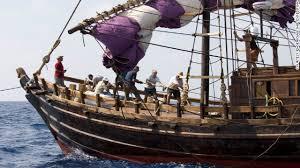
Piracy was something that was done to you. If you did it to somebody else, it was skirmishing, raiding, or “viking” depending on where you were, and it was perfectly all right. Nations just did this to each other. The Irish and the Scots were great raiders. All the Celtic tribes practiced raiding, and the Greek city-states had very small wars going on almost constantly over just this kind of thing.
The main reason the Norse were so hated for their “viking” was that they were just so good at it. Plus, the people they attacked didn’t have boats equal to the Norse longboats. This meant that the victims couldn’t go raid back, as was the custom.
A little closer to home for my American readers is the practice of the Native Americans. Young men of many tribes raided the neighbors. Horse-stealing was a fine art. It proved the initiative of the raider, enriched him, and made him look sexy for the girls. And while it wasn’t fun for the victims, this sort of thing wasn’t “war” in the sense that we understand it. It wasn’t about destroying people or goods. It was about getting rich.

If the raiding got out of hand – if too many innocents were hurt, if too much damage was done, older people would be called in to negotiate reparations. The Celtic tribes used similar methods to keep something like peace. It was mostly a matter of young men playing. And, as they say, whenever men play, they play at killing each other.
Which leads us to pirates.
The early Golden Age pirates – called the Buccaneering pirates – Raleigh, Drake, Hawkins, Morgan, were raiders in the old sense. Spain had money. England needed money. And Spain’s money was on the other side of the world, where no one was looking at it too closely. So these men showed their initiative by taking that money, bringing it home and sharing it with their own government.

The biggest differences here were the growing nationalism in Europe, and the issues of religion. The English raiders were Protestants, and to the Catholic Spanish, they were just as much Godless heathens as Muslims or American natives. The Spanish believed that God had given them all of North and South America, with the attendant gold and silver. Anyone stealing this money was acting against the wishes of God.
For this reason, the Spanish executed English pirates as soon as they caught them. This was hardly new- people had been killing pirates as often as they could be caught for a long time. But Spain continued its protests against English pirates by threatening – and later waging- war.Queen Elizabeth I, who loved pirates (and the money they brought home to England), knighted many of the original Buccaneers.
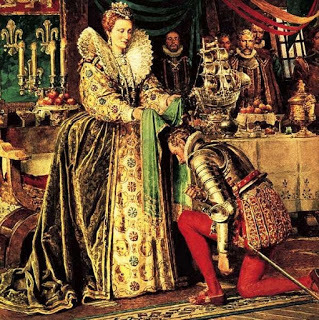
But when the true Golden Age of Piracy began, the rhetoric changed yet again. Suddenly pirates were “the enemies of God and men” “the scourge of all nations” “savages” and “unnatural.”
What changed?
The difference was that this time, the people in charge of the raiding, weren’t rich, and for the first time, the entities being robbed were neither nations nor individuals, but corporations. Individuals who are robbed don’t have a lot of recourse, and nations have a certain tolerance for small robberies, since doing something about it requires a lot of work.
Up until this point, raiding had been a rich man’s game. You needed the boat, and weapons, and that ran into a ton of money. Even if you weren’t rich yourself, you could become a pirate by convincing someone to give you command of their boat. So, when the profits were shared out, the owner and the captain got the largest share, and most of the cash stayed in the hands of the “upper crust”.
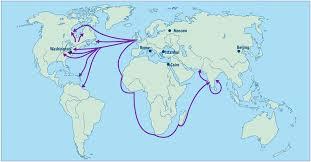
But corporations – and entities like the English East India Company (who later became powerful enough to maintain their own army and start their own wars) the West Indian Company, the Dutch West India Company, etc were insanely sensitive about being robbed, and they had the political clout to do something about it. They started the rhetoric that still echoes in the image of pirates being “evil” which lives on until this day. Highway robbers like Robin Hood have been romantic figures for a long time. Pirates, not so much.
In addition to ticking off the merchant corporations, early 18th century pirates also won the ire of insurance companies. Yes, almost all of the pirate’s victims had insurance. So, a small-time merchant might be annoyed by being robbed, but it probably wouldn’t ruin him. This may even have figured into the motives of certain pirates. Even today, fleecing an insurance company doesn’t carry the social disapproval of a “real crime”.
Pirates, usually working-class guys who had been repeatedly screwed by “the system” stood up for themselves when they captured treasure. They did not turn their prizes over to governments or financial backers. They kept it for themselves, and often flaunted laws which said that only people of hereditary wealth could wear certain clothing or eat certain foods.

When the powers that be saw “peasants” acting like they had just as much right to nice clothing and good food as rich folks, they went berserk. “God” had decided that certain people deserved to be rich, and He had showed His choices by making those people rich himself. That uneducated men, with no family connections or social standing should suddenly proclaim that they had just as much money as the next guy overturned a world view that had stood for millennia.
Of course, pirates were not the only ones who were fighting this fight. On land, people displaced by their landlords, workers whose wages had been reduced to below poverty wages, mistreated apprentices, and others combined into riotous mobs and fought for their rights.
The English government, influenced by the newly prosperous middle class, and by corporations and merchant associations, tried to control the lower classes by the use of harsher and harsher penalties, until well over two hundred crimes were punishable by death. It did not have much effect.
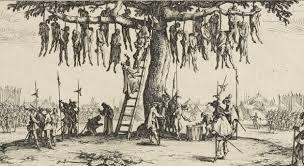
Being a pirate, helping pirates, and doing business with pirates was all illegal, but the penalties fell harshest on the deckhand level pirates that the authorities happened to catch. The authorities simply could not stand poor people who claimed to be just as good as the rich folks around them.
Many rich people still can’t. Statements like “Those laws don’t apply to us,” “Everyone can be rich if they just work hard enough,” and “Forty seven percent of people just want handouts,” prove that there’s nothing a rich person hates more than a poor person who wants to be equal.
So there are still pirates.
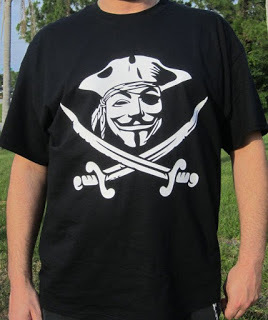
Piracy began with boats, and boats go back a long way. So long ago, in fact, that things like “laws” are hard to pin down. The earliest forms of piracy – practiced by the ancient Greeks and Phoenicians – was simply a matter of attacking people weaker than yourself, beating them up and taking their stuff. At the time, this was pretty much how all “international law” worked.

Piracy was something that was done to you. If you did it to somebody else, it was skirmishing, raiding, or “viking” depending on where you were, and it was perfectly all right. Nations just did this to each other. The Irish and the Scots were great raiders. All the Celtic tribes practiced raiding, and the Greek city-states had very small wars going on almost constantly over just this kind of thing.
The main reason the Norse were so hated for their “viking” was that they were just so good at it. Plus, the people they attacked didn’t have boats equal to the Norse longboats. This meant that the victims couldn’t go raid back, as was the custom.
A little closer to home for my American readers is the practice of the Native Americans. Young men of many tribes raided the neighbors. Horse-stealing was a fine art. It proved the initiative of the raider, enriched him, and made him look sexy for the girls. And while it wasn’t fun for the victims, this sort of thing wasn’t “war” in the sense that we understand it. It wasn’t about destroying people or goods. It was about getting rich.

If the raiding got out of hand – if too many innocents were hurt, if too much damage was done, older people would be called in to negotiate reparations. The Celtic tribes used similar methods to keep something like peace. It was mostly a matter of young men playing. And, as they say, whenever men play, they play at killing each other.
Which leads us to pirates.
The early Golden Age pirates – called the Buccaneering pirates – Raleigh, Drake, Hawkins, Morgan, were raiders in the old sense. Spain had money. England needed money. And Spain’s money was on the other side of the world, where no one was looking at it too closely. So these men showed their initiative by taking that money, bringing it home and sharing it with their own government.

The biggest differences here were the growing nationalism in Europe, and the issues of religion. The English raiders were Protestants, and to the Catholic Spanish, they were just as much Godless heathens as Muslims or American natives. The Spanish believed that God had given them all of North and South America, with the attendant gold and silver. Anyone stealing this money was acting against the wishes of God.
For this reason, the Spanish executed English pirates as soon as they caught them. This was hardly new- people had been killing pirates as often as they could be caught for a long time. But Spain continued its protests against English pirates by threatening – and later waging- war.Queen Elizabeth I, who loved pirates (and the money they brought home to England), knighted many of the original Buccaneers.

But when the true Golden Age of Piracy began, the rhetoric changed yet again. Suddenly pirates were “the enemies of God and men” “the scourge of all nations” “savages” and “unnatural.”
What changed?
The difference was that this time, the people in charge of the raiding, weren’t rich, and for the first time, the entities being robbed were neither nations nor individuals, but corporations. Individuals who are robbed don’t have a lot of recourse, and nations have a certain tolerance for small robberies, since doing something about it requires a lot of work.
Up until this point, raiding had been a rich man’s game. You needed the boat, and weapons, and that ran into a ton of money. Even if you weren’t rich yourself, you could become a pirate by convincing someone to give you command of their boat. So, when the profits were shared out, the owner and the captain got the largest share, and most of the cash stayed in the hands of the “upper crust”.

But corporations – and entities like the English East India Company (who later became powerful enough to maintain their own army and start their own wars) the West Indian Company, the Dutch West India Company, etc were insanely sensitive about being robbed, and they had the political clout to do something about it. They started the rhetoric that still echoes in the image of pirates being “evil” which lives on until this day. Highway robbers like Robin Hood have been romantic figures for a long time. Pirates, not so much.
In addition to ticking off the merchant corporations, early 18th century pirates also won the ire of insurance companies. Yes, almost all of the pirate’s victims had insurance. So, a small-time merchant might be annoyed by being robbed, but it probably wouldn’t ruin him. This may even have figured into the motives of certain pirates. Even today, fleecing an insurance company doesn’t carry the social disapproval of a “real crime”.
Pirates, usually working-class guys who had been repeatedly screwed by “the system” stood up for themselves when they captured treasure. They did not turn their prizes over to governments or financial backers. They kept it for themselves, and often flaunted laws which said that only people of hereditary wealth could wear certain clothing or eat certain foods.

When the powers that be saw “peasants” acting like they had just as much right to nice clothing and good food as rich folks, they went berserk. “God” had decided that certain people deserved to be rich, and He had showed His choices by making those people rich himself. That uneducated men, with no family connections or social standing should suddenly proclaim that they had just as much money as the next guy overturned a world view that had stood for millennia.
Of course, pirates were not the only ones who were fighting this fight. On land, people displaced by their landlords, workers whose wages had been reduced to below poverty wages, mistreated apprentices, and others combined into riotous mobs and fought for their rights.
The English government, influenced by the newly prosperous middle class, and by corporations and merchant associations, tried to control the lower classes by the use of harsher and harsher penalties, until well over two hundred crimes were punishable by death. It did not have much effect.

Being a pirate, helping pirates, and doing business with pirates was all illegal, but the penalties fell harshest on the deckhand level pirates that the authorities happened to catch. The authorities simply could not stand poor people who claimed to be just as good as the rich folks around them.
Many rich people still can’t. Statements like “Those laws don’t apply to us,” “Everyone can be rich if they just work hard enough,” and “Forty seven percent of people just want handouts,” prove that there’s nothing a rich person hates more than a poor person who wants to be equal.
So there are still pirates.

Published on July 20, 2015 17:57
July 13, 2015
A True, Modern Pirate Story
Pirates are known to inhabit just about anyplace there are boats. But the sea-robbers are most common where law-and-order is scant, where islands or uninhabited coastline provides convenient hiding places, and where unidentified people can come and go without arousing suspicion.
The Caribbean of the 18th century was just such a place, but many other parts of the earth also qualify. Today’s pirate story takes place in the South China Sea, a place that has been famous for its pirates almost from the dawn of recorded time.
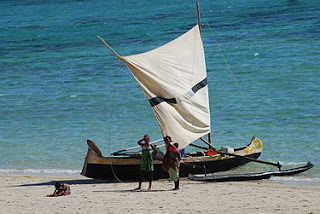
We open in about 1974, when a woman named France Guillain, of mixed French and Malaysian decent, took to sea in a 30-foot pirogue sailboat with her five children. She would remain on the boat, off-and-on, for nearly 14 years, experiencing life among sailors, natives and pirates. She wrote of her experiences in a feminist book titled Les Femmes d’abord . The book is available only in French, but this tale has been translated.
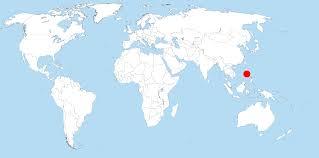
France was traveling from Hong Kong. She had held a course between Taiwan and China, and was now among the small, wild inlets northwest of the island of Luzon, largest island of the Philippines. This was an area that met all of the requirements for pirates, but France was not feeling particularly afraid, in spite of the fact that she had been warned.
“Do not,” she had been told, “go into any of the inlets. It is far better to spend the night in your boat on the open sea. The whole area is infested with the most dangerous of pirates, and they frequently spend their evenings in these private inlets. Stay away!”

But, while not a reckless woman – for she could not have been, and kept her family safe so far on her journey - on this particular evening, France decided to ignore the warnings she had heard and pull into a sheltered cove for the night. Below her keel were rough coral reefs, and the tides and currents between them made ripping out the bottom of her fragile craft a real possibility.
She investigated such a cove during the late afternoon, and was encouraged to find two other pirogue boats already pulled up on the shore. She heaved a sigh of relief when she noticed children paying beside the craft. Women were in the early stages of preparing food, and a grandmotherly type watched over a sleeping infant. In all, there were nearly 30 people, whose interest was centered around their campfire, and the two cooking pots hung over it.

The group appeared to simply be traveling natives. When France beached her boat and approached the group, she was warmly greeted in English by a man who introduced himself and his wife, Linda.Linda and France spoke no common language, but they were held together by the bonds of womanhood and motherhood, and were almost immediately friendly. Together they watched France’s girls play with the native children, and worked together to finish preparing the meal.
As evening fell, France noticed that the circling headlands would hide the light of the group's fire from pirates upon the open sea. She felt even more safe with her new friends.
After eating, the young men of the group pulled out ukuleles , and sang while Linda danced. France recognized the tune, and felt that she was back in her home in Tahiti. She sang a song of her own, and the young men had no trouble picking up the tune. Then Linda showed her some dance steps, and they danced together under the stars.

Linda took her dozing children back to their boat to sleep, while Linda and her husband held some sort of serious discussion. Overhead, the stars were bright. France felt secure in the safety of the surrounding cliffs and near the presence of the large group of peaceful islanders. Surely no pirates would dare attack her here.
Just as she was tucking in her sleepy girls, Linda’s husband approached her with something important to say. “You must never come to these coves again,” he said seriously. “It’s not safe.”
“Why?” France laughed in return. “Because of pirates?”
“Yes,” said the man. “They have no mercy. They kill everyone, even the children. Linda is afraid something bad will happen to you.”
“Is she afraid of pirates?”
“WE are the pirates!” the man told her. Then he led here to one of his two boats, where France saw piles of electronics, nautical equipment – and machine guns.

“Go now.” The man told her. “Don’t come back.”
Linda, her parents, and her children, were part of a tribe of hereditary pirates, born and bred to the trade. Was France saved because the pirates were already loaded with plunder? Because they didn’t want to foul the white sand of their hiding place with her blood? Or because she knew the same songs they did, and was not too shy to dance?
This story took place in 1974. Piracy is still real.

The Caribbean of the 18th century was just such a place, but many other parts of the earth also qualify. Today’s pirate story takes place in the South China Sea, a place that has been famous for its pirates almost from the dawn of recorded time.

We open in about 1974, when a woman named France Guillain, of mixed French and Malaysian decent, took to sea in a 30-foot pirogue sailboat with her five children. She would remain on the boat, off-and-on, for nearly 14 years, experiencing life among sailors, natives and pirates. She wrote of her experiences in a feminist book titled Les Femmes d’abord . The book is available only in French, but this tale has been translated.

France was traveling from Hong Kong. She had held a course between Taiwan and China, and was now among the small, wild inlets northwest of the island of Luzon, largest island of the Philippines. This was an area that met all of the requirements for pirates, but France was not feeling particularly afraid, in spite of the fact that she had been warned.
“Do not,” she had been told, “go into any of the inlets. It is far better to spend the night in your boat on the open sea. The whole area is infested with the most dangerous of pirates, and they frequently spend their evenings in these private inlets. Stay away!”

But, while not a reckless woman – for she could not have been, and kept her family safe so far on her journey - on this particular evening, France decided to ignore the warnings she had heard and pull into a sheltered cove for the night. Below her keel were rough coral reefs, and the tides and currents between them made ripping out the bottom of her fragile craft a real possibility.
She investigated such a cove during the late afternoon, and was encouraged to find two other pirogue boats already pulled up on the shore. She heaved a sigh of relief when she noticed children paying beside the craft. Women were in the early stages of preparing food, and a grandmotherly type watched over a sleeping infant. In all, there were nearly 30 people, whose interest was centered around their campfire, and the two cooking pots hung over it.

The group appeared to simply be traveling natives. When France beached her boat and approached the group, she was warmly greeted in English by a man who introduced himself and his wife, Linda.Linda and France spoke no common language, but they were held together by the bonds of womanhood and motherhood, and were almost immediately friendly. Together they watched France’s girls play with the native children, and worked together to finish preparing the meal.
As evening fell, France noticed that the circling headlands would hide the light of the group's fire from pirates upon the open sea. She felt even more safe with her new friends.
After eating, the young men of the group pulled out ukuleles , and sang while Linda danced. France recognized the tune, and felt that she was back in her home in Tahiti. She sang a song of her own, and the young men had no trouble picking up the tune. Then Linda showed her some dance steps, and they danced together under the stars.

Linda took her dozing children back to their boat to sleep, while Linda and her husband held some sort of serious discussion. Overhead, the stars were bright. France felt secure in the safety of the surrounding cliffs and near the presence of the large group of peaceful islanders. Surely no pirates would dare attack her here.
Just as she was tucking in her sleepy girls, Linda’s husband approached her with something important to say. “You must never come to these coves again,” he said seriously. “It’s not safe.”
“Why?” France laughed in return. “Because of pirates?”
“Yes,” said the man. “They have no mercy. They kill everyone, even the children. Linda is afraid something bad will happen to you.”
“Is she afraid of pirates?”
“WE are the pirates!” the man told her. Then he led here to one of his two boats, where France saw piles of electronics, nautical equipment – and machine guns.

“Go now.” The man told her. “Don’t come back.”
Linda, her parents, and her children, were part of a tribe of hereditary pirates, born and bred to the trade. Was France saved because the pirates were already loaded with plunder? Because they didn’t want to foul the white sand of their hiding place with her blood? Or because she knew the same songs they did, and was not too shy to dance?
This story took place in 1974. Piracy is still real.

Published on July 13, 2015 18:03
July 6, 2015
Were Pirates Gay?
One of the most persistent questions asked of this blog is always, "Were pirates gay?" I have an article about homosexuality among pirates here, stating that pirates were no more or less homosexual than any other sailors at the time, but that they did not criminalize the behavior.

But I don't think this answers the question. Pirates were referred to at the time, as "Gaye Fellowes". What's up with that? Why is the word so often used?
The fact is, pirates WERE gay. They were NOT homosexual.
The secret here is that words change in meaning, and the word "Gay" has changed a lot since it came into the English language.
When I write this - that words change in meaning - I can almost hear someone shouting, "No, they don't! Words mean things. They always mean the same things. Just look in a dictionary!" Yes, I know, the idea that language isn't always the same is disturbing to some people. But language NEEDS to change, to keep up with our changing world. And if you doubt me, get a copy of the Oxford English Dictionary, which gives the history of the meaning of each word it contains, and start reading up on how the meanings of some words has evolved.

Sometimes new words come into being. Words like "internet" "flashmob" "television" and even "airplane" were invented because new things were invented. Similarly, as people come to think differently about existing things, the words used to describe those things change.
Face it, there was a point in time where "bad" meant "good".

The word "gay" came to English from the French gai, some time about 1100. It meant "carefree, happy, having a good time". People spoke of being gay, having a gay time, and it had nothing to do with homosexuality.
However, England was a Protestant nation, and during the 1600's it began to adhere to what is called The Protestant Work Ethic. This philosophy says if you are not working, you're probably up to no good. The saying "Idle hands are the devil's workshop" pretty well sums it up. If you were working (planting wheat, weaving cloth, cooking) that was fine, but if you were not actively at work, you should still be doing something useful. like learning to play the piano or reading your Bible.
(This ideal reached its peak in the Industrial Age, when factory owners claimed that it was good for their employees to work 14-hour days, because otherwise they would be "idle".)
So, the word "gay" began to mean fooling around, sitting on your butt, or just generally being irresponsible. By about 1700, the word referred to someone who was spending too much time doing things that society didn't approve of, such as drinking, eating fine food, dancing, singing, or having sex. So the word was perfect for pirates. They loved to sing, dance, eat, drink and have sex, and society didn't approve of them at all.
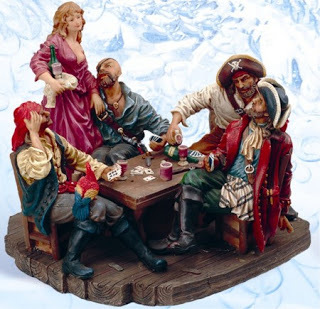
Later, the word changed in meaning once again. During the 1800's it became a euphemism (word used because in place of another word that sounds too rude, crude or clinical) to talk about someone who was having too much sex, and with too many people.
You can still see echos of this in old black-and-white Hollywood movies. A woman will ask a man, "Don't you think I'm gay company?" and it probably means "Don't you think I'm good in bed?" During the same time period, "having a few laughs" could mean "having sex". People weren't comfortable talking about sex, and a person who was uptight could easily pretend that "gay" still meant "happy".

From there it was an easy step for homosexuals to use "gay" as a code word. Remember, up until 1962 it was illegal for two men to have sex in the United States, and people who were caught doing it could be sent to jail for years. And in England, just being gay (not even doing anything about it) brought a jail term and/or castration. So it was really, really important to have an innocent way to hint at what you were. Later, when homosexual men began to fight for the right to be themselves without penalty, they adopted the word "gay" officially, because "homosexual" sounded too much like a disease.
So: Pirates were gay, according to the use of the word during their time period, but were not homosexual. The word changed meanings.
Another sea-faring word that has changed meaning over the years is the word "Bully" Today it means a person who torments or picks on people who have difficulty fighting back. Bullies are accepted as being cowards.
In the Golden Age of Pirates however, the word had almost exactly the opposite meaning. Being "bully" meant being "like a bull". In other words, strong, self-assured, and brave. Sailors, who faced terrifying dangers at sea, and often went ashore in ports where they didn't speak the language and didn't know the customs, took pride in being "bully". They went into strange places and faced real danger and felt no fear. (Of if they did, they hid it extremely well.)

Sea Shanties like "Heave Away Me Bully Boys" and "Bully in the Alley" still remain as a testament to this time.
However, as Europe expanded her powers into the Third World, colonizing existing nations, these same visiting sailors (and soldiers) began to believe that they had the right to impose their own culture on conquered nations. If they didn't like the way native people were acting they might start a fight. If they believed that a woman was dressed like a prostitute, they might rape her. Since they were in a conquered nation, they felt they could "throw their weight around." In short, these men became "bullies" in the modern sense.
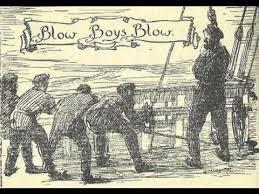

But I don't think this answers the question. Pirates were referred to at the time, as "Gaye Fellowes". What's up with that? Why is the word so often used?
The fact is, pirates WERE gay. They were NOT homosexual.
The secret here is that words change in meaning, and the word "Gay" has changed a lot since it came into the English language.
When I write this - that words change in meaning - I can almost hear someone shouting, "No, they don't! Words mean things. They always mean the same things. Just look in a dictionary!" Yes, I know, the idea that language isn't always the same is disturbing to some people. But language NEEDS to change, to keep up with our changing world. And if you doubt me, get a copy of the Oxford English Dictionary, which gives the history of the meaning of each word it contains, and start reading up on how the meanings of some words has evolved.

Sometimes new words come into being. Words like "internet" "flashmob" "television" and even "airplane" were invented because new things were invented. Similarly, as people come to think differently about existing things, the words used to describe those things change.
Face it, there was a point in time where "bad" meant "good".

The word "gay" came to English from the French gai, some time about 1100. It meant "carefree, happy, having a good time". People spoke of being gay, having a gay time, and it had nothing to do with homosexuality.
However, England was a Protestant nation, and during the 1600's it began to adhere to what is called The Protestant Work Ethic. This philosophy says if you are not working, you're probably up to no good. The saying "Idle hands are the devil's workshop" pretty well sums it up. If you were working (planting wheat, weaving cloth, cooking) that was fine, but if you were not actively at work, you should still be doing something useful. like learning to play the piano or reading your Bible.
(This ideal reached its peak in the Industrial Age, when factory owners claimed that it was good for their employees to work 14-hour days, because otherwise they would be "idle".)
So, the word "gay" began to mean fooling around, sitting on your butt, or just generally being irresponsible. By about 1700, the word referred to someone who was spending too much time doing things that society didn't approve of, such as drinking, eating fine food, dancing, singing, or having sex. So the word was perfect for pirates. They loved to sing, dance, eat, drink and have sex, and society didn't approve of them at all.

Later, the word changed in meaning once again. During the 1800's it became a euphemism (word used because in place of another word that sounds too rude, crude or clinical) to talk about someone who was having too much sex, and with too many people.
You can still see echos of this in old black-and-white Hollywood movies. A woman will ask a man, "Don't you think I'm gay company?" and it probably means "Don't you think I'm good in bed?" During the same time period, "having a few laughs" could mean "having sex". People weren't comfortable talking about sex, and a person who was uptight could easily pretend that "gay" still meant "happy".

From there it was an easy step for homosexuals to use "gay" as a code word. Remember, up until 1962 it was illegal for two men to have sex in the United States, and people who were caught doing it could be sent to jail for years. And in England, just being gay (not even doing anything about it) brought a jail term and/or castration. So it was really, really important to have an innocent way to hint at what you were. Later, when homosexual men began to fight for the right to be themselves without penalty, they adopted the word "gay" officially, because "homosexual" sounded too much like a disease.
So: Pirates were gay, according to the use of the word during their time period, but were not homosexual. The word changed meanings.
Another sea-faring word that has changed meaning over the years is the word "Bully" Today it means a person who torments or picks on people who have difficulty fighting back. Bullies are accepted as being cowards.
In the Golden Age of Pirates however, the word had almost exactly the opposite meaning. Being "bully" meant being "like a bull". In other words, strong, self-assured, and brave. Sailors, who faced terrifying dangers at sea, and often went ashore in ports where they didn't speak the language and didn't know the customs, took pride in being "bully". They went into strange places and faced real danger and felt no fear. (Of if they did, they hid it extremely well.)

Sea Shanties like "Heave Away Me Bully Boys" and "Bully in the Alley" still remain as a testament to this time.
However, as Europe expanded her powers into the Third World, colonizing existing nations, these same visiting sailors (and soldiers) began to believe that they had the right to impose their own culture on conquered nations. If they didn't like the way native people were acting they might start a fight. If they believed that a woman was dressed like a prostitute, they might rape her. Since they were in a conquered nation, they felt they could "throw their weight around." In short, these men became "bullies" in the modern sense.

Published on July 06, 2015 16:22
June 29, 2015
The Truth about Somali Pirates
This is a serious, dark post about modern-day criminals. Not for the faint of heart.
People have been bringing this subject up with me for years. Somali Pirates. They’re the bad guys. Without provocation, they take their boats out and terrorize helpless merchant shipping. They kidnap Americans, torture them, hold them for ransom. They have nothing in common with the jolly pirates of yore.

Except that it’s not that cut and dried. Let me tell you the story of the Pirates of SomaliaLike many African stories, this one has its beginning in the 1800’s. Somalia, like many third-world countries, was occupied by European powers seeking to establish empires. By 1949, what we now call Somalia was divided between Italy and Great Britain. Italy built up the infrastructure in their half. Great Britain, not so much.

On July 1, 1960, these territories combined into the Somali Republic. Much of it’s interior grazing lands had been lost to France, and the nation was reduced to a narrow strip of land along the Arabian Sea and the Gulf of Aden. In addition, the two halves of the country had different government and legal systems, adopted from their conquerors.
Nevertheless, the Somalis established a government which lasted 10 years, until the president was assassinated. The leader of the army took over with no opposition. The new leadership worked to create better infrastructure and improve literacy, with great success. Then, in 1977, the military government disbanded itself in favor of what was essentially a communist administration.

In an effort to regain some of its lost territory, Somali began s series of tribal wars. These were going well for the Somalis, until the Soviet Union (who should have sided with the now-communist Somalia) brought in 20,000 Cuban troops and several thousand Soviet “advisors” to beat back the Somalis.
The Somalis mover their allegiance to the USSR’s cold-war enemy, the United States. They also established a military dictatorship, which lasted for roughly ten years. In 1991, civil war broke out.It has been claimed that much of the instability in the region was caused by the American government, then headed by President George H. W. Bush. The US had been successful in manipulating other third-world governments. Somalia’s land contained untapped oil, which the US wanted to hold in reserve. Supposedly, it was believed that by keeping the Somali government in near total chaos, America could, at any time, step in the “rescue” the beleaguered country.

During the 1990’s Somalia had no functional government. I remember reading that competing warlords were using black-market Soviet surplus weapons to hold small portions of the country. In the meantime, infrastructure had broken down so badly that the Somalia Boy Scouts were gathering and interring the bodies of the dead. The Boy Scouts were the only “government” left.I wept when I read that.
A friend served in the US Marines during this time period. He will not speak about what he saw.
 This is the least horrifying photo of a Somali child that I could find.
This is the least horrifying photo of a Somali child that I could find.
You may think that the situation could get no worse for the Somali people, but you would be wrong.
Throughout these chaotic times, the fishermen of the country had fed the people, going out with small boats and bringing home enough to prevent starvation in their villages. But in the absence of an organized military or diplomatic corps, European and Asia industrial fishing fleets stripped the waters of their bounty. And to make matters even worse, these same powers dumped unsheilded nuclear waste into Somali waters. There was no one to stop them.
[image error]
So, the position was this: No food, and no ability to use traditional methods to obtain food. What fish remained showed heavy mutation. Then storms tore open the flimsy barrels containing the radioactive waste, and drove the leaking containers onto the beaches. Somali men women and children began to suffer from radiation sickness.
The only resources left were the Soviet assault rifles and the disused fishing boats. A pirate fleet was born.

Like the pirates of the 1700’s these people had nothing left to lose.
I’ve heard ideas for stopping the Somali pirates. These ideas usually involve the kinds of firepower that only the US can bring to bear, and scenarios that could fuel the next Terminator movie. It's true that some of the pirates are the same criminals who helped bring the country into chaos. But many are simply unemployed fishermen, and some of these people are already dead. They have absorbed deadly doses of radiation. And they are fighting to feed their children.
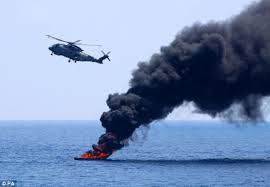
Bombs, napalm and heavy artillery can’t change these people’s determination, any more than the threat of hanging stopped the original pirates.
How can we stop the Somalis? Well, for starters, we could do what ended the Golden Age of Piracy: Offer a full pardon. And then we might clean up the radioactive mess, and get the kids something to eat. This would go a long way to bringing peace.

Note: Many of the so-called Somali pirates sail under the flag of the Somali naval militia.
People have been bringing this subject up with me for years. Somali Pirates. They’re the bad guys. Without provocation, they take their boats out and terrorize helpless merchant shipping. They kidnap Americans, torture them, hold them for ransom. They have nothing in common with the jolly pirates of yore.

Except that it’s not that cut and dried. Let me tell you the story of the Pirates of SomaliaLike many African stories, this one has its beginning in the 1800’s. Somalia, like many third-world countries, was occupied by European powers seeking to establish empires. By 1949, what we now call Somalia was divided between Italy and Great Britain. Italy built up the infrastructure in their half. Great Britain, not so much.

On July 1, 1960, these territories combined into the Somali Republic. Much of it’s interior grazing lands had been lost to France, and the nation was reduced to a narrow strip of land along the Arabian Sea and the Gulf of Aden. In addition, the two halves of the country had different government and legal systems, adopted from their conquerors.
Nevertheless, the Somalis established a government which lasted 10 years, until the president was assassinated. The leader of the army took over with no opposition. The new leadership worked to create better infrastructure and improve literacy, with great success. Then, in 1977, the military government disbanded itself in favor of what was essentially a communist administration.

In an effort to regain some of its lost territory, Somali began s series of tribal wars. These were going well for the Somalis, until the Soviet Union (who should have sided with the now-communist Somalia) brought in 20,000 Cuban troops and several thousand Soviet “advisors” to beat back the Somalis.
The Somalis mover their allegiance to the USSR’s cold-war enemy, the United States. They also established a military dictatorship, which lasted for roughly ten years. In 1991, civil war broke out.It has been claimed that much of the instability in the region was caused by the American government, then headed by President George H. W. Bush. The US had been successful in manipulating other third-world governments. Somalia’s land contained untapped oil, which the US wanted to hold in reserve. Supposedly, it was believed that by keeping the Somali government in near total chaos, America could, at any time, step in the “rescue” the beleaguered country.

During the 1990’s Somalia had no functional government. I remember reading that competing warlords were using black-market Soviet surplus weapons to hold small portions of the country. In the meantime, infrastructure had broken down so badly that the Somalia Boy Scouts were gathering and interring the bodies of the dead. The Boy Scouts were the only “government” left.I wept when I read that.
A friend served in the US Marines during this time period. He will not speak about what he saw.
 This is the least horrifying photo of a Somali child that I could find.
This is the least horrifying photo of a Somali child that I could find.You may think that the situation could get no worse for the Somali people, but you would be wrong.
Throughout these chaotic times, the fishermen of the country had fed the people, going out with small boats and bringing home enough to prevent starvation in their villages. But in the absence of an organized military or diplomatic corps, European and Asia industrial fishing fleets stripped the waters of their bounty. And to make matters even worse, these same powers dumped unsheilded nuclear waste into Somali waters. There was no one to stop them.
[image error]
So, the position was this: No food, and no ability to use traditional methods to obtain food. What fish remained showed heavy mutation. Then storms tore open the flimsy barrels containing the radioactive waste, and drove the leaking containers onto the beaches. Somali men women and children began to suffer from radiation sickness.
The only resources left were the Soviet assault rifles and the disused fishing boats. A pirate fleet was born.

Like the pirates of the 1700’s these people had nothing left to lose.
I’ve heard ideas for stopping the Somali pirates. These ideas usually involve the kinds of firepower that only the US can bring to bear, and scenarios that could fuel the next Terminator movie. It's true that some of the pirates are the same criminals who helped bring the country into chaos. But many are simply unemployed fishermen, and some of these people are already dead. They have absorbed deadly doses of radiation. And they are fighting to feed their children.

Bombs, napalm and heavy artillery can’t change these people’s determination, any more than the threat of hanging stopped the original pirates.
How can we stop the Somalis? Well, for starters, we could do what ended the Golden Age of Piracy: Offer a full pardon. And then we might clean up the radioactive mess, and get the kids something to eat. This would go a long way to bringing peace.

Note: Many of the so-called Somali pirates sail under the flag of the Somali naval militia.
Published on June 29, 2015 18:34
June 22, 2015
Why are Ships Female?
Ships as women, women as ships. The comparison has built itself into the Western psyche, even in an age when grammarians and feminists alike disapprove of the comparison. Why is it so compelling?
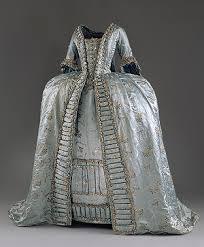
The era of sailing ships aligns most exactly with an ear when women wore large, wide, impressive dresses, and often distinguished themselves by revealing a great deal of bosom. The resemblance between a well-dressed woman, her skirts rustling like a ship’s sails, moving forward through a crowd of people, who stepped out of her way like the waves parting before a ship’s prow, was unmistakable. A woman so dressed had the gravitas of a large merchant vessel or warship.
But a young girl with sort skirts, laughing and dancing and kicking up her heels seemed more like a small dory or rowboat. She probably doesn’t travel in a straight line very often. Instead she skitters this way and that, lightly, quickly, and unpredictably.
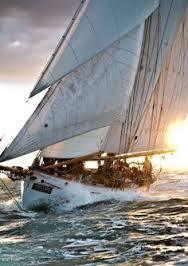
Like ships, women are not composed of straight lines. Some racers are narrow, smooth and fast. Others, like merchant ships, are wide across the beam, stocky, solid and likely to carry and care for a large number of people.
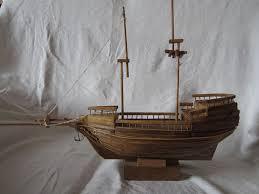
I personally have had one of the unforgettable experiences of a lifetime, which is to be on the deck of a wooden ship when the wind reached her sails and she came alive. Unlike steel ships, wooden vessels were made to flex, to bend with the wind, creating the sensation that the ship is breathing. Anyone who has be privileged to feel this knows that the ship is alive. Living things have genders.
There are many humorous stories about ships and women. It is said that women and ships look very good when fresh-painted (make-up). Ships never leave port asleep. They leave awake (a wake). Ships always head toward the buoys (pronounced ‘boys’ these are lane makers that show the area it is safe to sail through.) She always has a crowd of men around her. Or, as the old song goes:
She carries her bow high, Her stern is nice and roundIt’s easy to hold her when she is sheeted down…

There are many remarks about the personality of ships. Like a woman, a ship is endlessly variable. She is in tune with the sea around her, and as such, she may not do just what the men around her want her to do. Caught between a headwind and a contrary sea, even a staid matronly cargo ship can cut some energetic capers, tossing her masts around in figure eights, bouncing her bow clear of the water, shaking her stern, and generally doing her own thing while the men who depend on her can do little more than hold on.
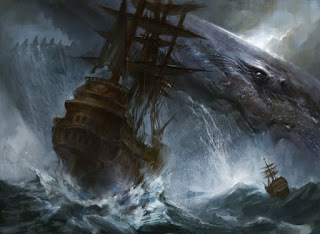
And yet the same ship will hold firm in the face of the worst possible conditions, hold it together in the face of unbelievable adversity. She will go to unbelievable lengths to protect those who depend on her. Wooden ships are what they are, and they nurture those around them.
And most of all, the reason why tall ships are so much like women? The one thing that everyone agrees with?
Because men love them.
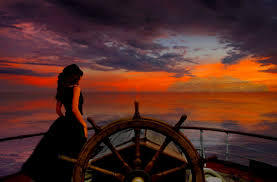

The era of sailing ships aligns most exactly with an ear when women wore large, wide, impressive dresses, and often distinguished themselves by revealing a great deal of bosom. The resemblance between a well-dressed woman, her skirts rustling like a ship’s sails, moving forward through a crowd of people, who stepped out of her way like the waves parting before a ship’s prow, was unmistakable. A woman so dressed had the gravitas of a large merchant vessel or warship.
But a young girl with sort skirts, laughing and dancing and kicking up her heels seemed more like a small dory or rowboat. She probably doesn’t travel in a straight line very often. Instead she skitters this way and that, lightly, quickly, and unpredictably.

Like ships, women are not composed of straight lines. Some racers are narrow, smooth and fast. Others, like merchant ships, are wide across the beam, stocky, solid and likely to carry and care for a large number of people.

I personally have had one of the unforgettable experiences of a lifetime, which is to be on the deck of a wooden ship when the wind reached her sails and she came alive. Unlike steel ships, wooden vessels were made to flex, to bend with the wind, creating the sensation that the ship is breathing. Anyone who has be privileged to feel this knows that the ship is alive. Living things have genders.
There are many humorous stories about ships and women. It is said that women and ships look very good when fresh-painted (make-up). Ships never leave port asleep. They leave awake (a wake). Ships always head toward the buoys (pronounced ‘boys’ these are lane makers that show the area it is safe to sail through.) She always has a crowd of men around her. Or, as the old song goes:
She carries her bow high, Her stern is nice and roundIt’s easy to hold her when she is sheeted down…

There are many remarks about the personality of ships. Like a woman, a ship is endlessly variable. She is in tune with the sea around her, and as such, she may not do just what the men around her want her to do. Caught between a headwind and a contrary sea, even a staid matronly cargo ship can cut some energetic capers, tossing her masts around in figure eights, bouncing her bow clear of the water, shaking her stern, and generally doing her own thing while the men who depend on her can do little more than hold on.

And yet the same ship will hold firm in the face of the worst possible conditions, hold it together in the face of unbelievable adversity. She will go to unbelievable lengths to protect those who depend on her. Wooden ships are what they are, and they nurture those around them.
And most of all, the reason why tall ships are so much like women? The one thing that everyone agrees with?
Because men love them.

Published on June 22, 2015 18:47
June 15, 2015
What’s Wrong With Master and Commander?
Since I have strongly recommended the movie Master and Commander: The Far Side of the World” the as research for Golden Age pirate lovers, you may be thinking you’ve found a treasure trove, and you should follow ever detail. The movie, starring Russel Crowe, and the books by Patrick O'Brian, have won acclaim. And they're about sailing ships! How much more relevant to pirates can you get?
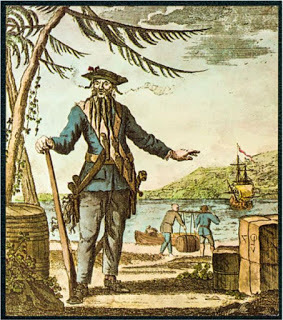
That isn’t the case, unfortunately. The movie – and the many books – are wonderful, but they fall into a category that makes them much less useful to us.
They are set almost exactly 100 years too late.
O’Brian’s masterwork, like many – or even most – stories of sea-going adventure, is set during the Napoleonic Wars. When I first found these books 10 years ago I didn’t care much about that little detail. After all, they were sailing ships, with masts, and lots of white canvas sails. How different could they be?
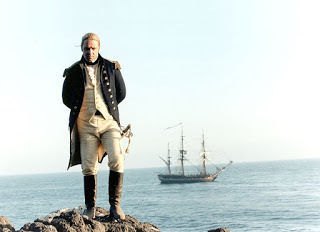
About as different as a Model T Ford and a modern Lexis.
Let’s look at some basic facts. The Queen Anne’s Revenge, the pirate ship that terrified merchants from Boston to Jamaica, and nearly stopped all commerce in the Caribbean. She was considered an enormous vessel, 103 feet long, 36 feet wide, rated at 300 tons, carrying 40 guns and harboring a crew of about 125 pirates.
(A note here – Being “rated” at a certain weight is a way of defining the size of a ship. A formula using the length and width of the ship calculated the approximate internal volume available for cargo, water and other supplies. The same calculation was used from about 1650 until the advent of steam power.)
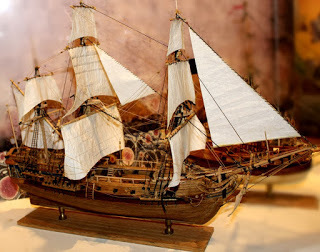 Model of the Queen Anne's Revenge - notice how much rope.
Model of the Queen Anne's Revenge - notice how much rope.
In contrast, the standard battle ship of the Napoleonic wars was the “74”. These ships averaged 180 feet long and 46 feet wide, and rated 2,000 to 3,000 tons. The “74” stood for the number of cannons. Crews regularly included 700 men.This made the navy ship of the later era 10 times as big as the most fearsome pirate vessel of all times, with nearly twice the armament. Large navy ships might carry as many as 110 guns.
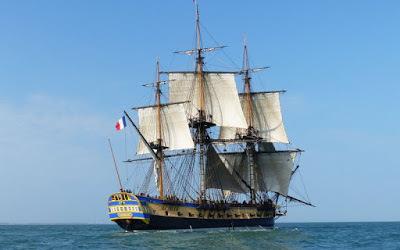 Replica of Hermione from the Napoleonic era. Rope, lost of rope.
Replica of Hermione from the Napoleonic era. Rope, lost of rope.
Speed developed, too. At about 1700, the average speed for many ships was 6 knots (about 6 ½ miles per hour) but by the early 1800’s, average speeds were nearly double, and some ships reached speeds of 20 knots (23 mph). For reference, Modern oil tankers generally cannot exceed 16 knots in speed.
Part of this was achieved through improved hull design, some of it through more advanced sail plans. Ships from the 1700’s carried and used a lot of rope. But by the 1800’s, rope work was literally so highly developed that it was accomplishing things that we do today with electronics. The Royal Navy of the Napoleonic wars had vast sources of supply, and used every type of rope imaginable – left hand twists, right hand twists, a variety of materials, thicknesses ranging from string to ropes as thick as a man’s waist.

In addition, the war caused a vast rush toward standardization. The navy needed tools, barrels, guns, and ship supplies, and they ordered them by the thousands. Businesses arose to make one thing – for instance blocks. During the Age of Piracy, every item on a ship was probably hand crafted by a jack-of-all-trades carpenter. In the Age of the Navy, almost every item was mass-produced.
Furthermore, trade had changed considerably. During the Golden Age of Piracy, merchant vessels did not have regular trade routes. Merchant captains scraped together a cargo, and then transported it wherever they could make a profit. Often ships sat in port for weeks or months, while the captain tried to put together enough goods for a profitable voyage. In the meantime, the sailors loitered in the port city, unpaid, getting into trouble.
 Double ship's wheel from an 1800's replica ship
Double ship's wheel from an 1800's replica ship
Bored, unemployed sailors supported apprentices who were fighting for improved rights, participated in labor riots, and often ended up in jail. Communities, in turn, took steps to control sailors while they were on shore, and this led to resentments which drove some men toward piracy.
By the Napoleonic wars, trade routes were much more regular. Ships were too valuable to be allowed to stand idle. Port cities in North America and the Caribbean expected ships to come regularly. Infrastructure such as warehouses, docks and shipyards had grown tremendously in the New World. During the Golden Age, Caribbean and the Americas were still wilderness. And while the area could not be called “tame” during the early 1800’s, it was, well, closer to that state.
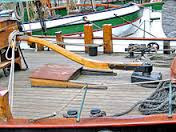 Tiller. Though the ship's wheel existed during the 1700's many vessels
Tiller. Though the ship's wheel existed during the 1700's many vessels
still used this more primitive steering mechanism.
So – watch this wonderful movie, read these wonderful books. Learn a lot. Just be aware that what you are learning is only slightly related to Piracy’s Golden Age.


That isn’t the case, unfortunately. The movie – and the many books – are wonderful, but they fall into a category that makes them much less useful to us.
They are set almost exactly 100 years too late.
O’Brian’s masterwork, like many – or even most – stories of sea-going adventure, is set during the Napoleonic Wars. When I first found these books 10 years ago I didn’t care much about that little detail. After all, they were sailing ships, with masts, and lots of white canvas sails. How different could they be?

About as different as a Model T Ford and a modern Lexis.
Let’s look at some basic facts. The Queen Anne’s Revenge, the pirate ship that terrified merchants from Boston to Jamaica, and nearly stopped all commerce in the Caribbean. She was considered an enormous vessel, 103 feet long, 36 feet wide, rated at 300 tons, carrying 40 guns and harboring a crew of about 125 pirates.
(A note here – Being “rated” at a certain weight is a way of defining the size of a ship. A formula using the length and width of the ship calculated the approximate internal volume available for cargo, water and other supplies. The same calculation was used from about 1650 until the advent of steam power.)
 Model of the Queen Anne's Revenge - notice how much rope.
Model of the Queen Anne's Revenge - notice how much rope.In contrast, the standard battle ship of the Napoleonic wars was the “74”. These ships averaged 180 feet long and 46 feet wide, and rated 2,000 to 3,000 tons. The “74” stood for the number of cannons. Crews regularly included 700 men.This made the navy ship of the later era 10 times as big as the most fearsome pirate vessel of all times, with nearly twice the armament. Large navy ships might carry as many as 110 guns.
 Replica of Hermione from the Napoleonic era. Rope, lost of rope.
Replica of Hermione from the Napoleonic era. Rope, lost of rope.Speed developed, too. At about 1700, the average speed for many ships was 6 knots (about 6 ½ miles per hour) but by the early 1800’s, average speeds were nearly double, and some ships reached speeds of 20 knots (23 mph). For reference, Modern oil tankers generally cannot exceed 16 knots in speed.
Part of this was achieved through improved hull design, some of it through more advanced sail plans. Ships from the 1700’s carried and used a lot of rope. But by the 1800’s, rope work was literally so highly developed that it was accomplishing things that we do today with electronics. The Royal Navy of the Napoleonic wars had vast sources of supply, and used every type of rope imaginable – left hand twists, right hand twists, a variety of materials, thicknesses ranging from string to ropes as thick as a man’s waist.

In addition, the war caused a vast rush toward standardization. The navy needed tools, barrels, guns, and ship supplies, and they ordered them by the thousands. Businesses arose to make one thing – for instance blocks. During the Age of Piracy, every item on a ship was probably hand crafted by a jack-of-all-trades carpenter. In the Age of the Navy, almost every item was mass-produced.
Furthermore, trade had changed considerably. During the Golden Age of Piracy, merchant vessels did not have regular trade routes. Merchant captains scraped together a cargo, and then transported it wherever they could make a profit. Often ships sat in port for weeks or months, while the captain tried to put together enough goods for a profitable voyage. In the meantime, the sailors loitered in the port city, unpaid, getting into trouble.
 Double ship's wheel from an 1800's replica ship
Double ship's wheel from an 1800's replica shipBored, unemployed sailors supported apprentices who were fighting for improved rights, participated in labor riots, and often ended up in jail. Communities, in turn, took steps to control sailors while they were on shore, and this led to resentments which drove some men toward piracy.
By the Napoleonic wars, trade routes were much more regular. Ships were too valuable to be allowed to stand idle. Port cities in North America and the Caribbean expected ships to come regularly. Infrastructure such as warehouses, docks and shipyards had grown tremendously in the New World. During the Golden Age, Caribbean and the Americas were still wilderness. And while the area could not be called “tame” during the early 1800’s, it was, well, closer to that state.
 Tiller. Though the ship's wheel existed during the 1700's many vessels
Tiller. Though the ship's wheel existed during the 1700's many vessels still used this more primitive steering mechanism.
So – watch this wonderful movie, read these wonderful books. Learn a lot. Just be aware that what you are learning is only slightly related to Piracy’s Golden Age.

Published on June 15, 2015 19:46



